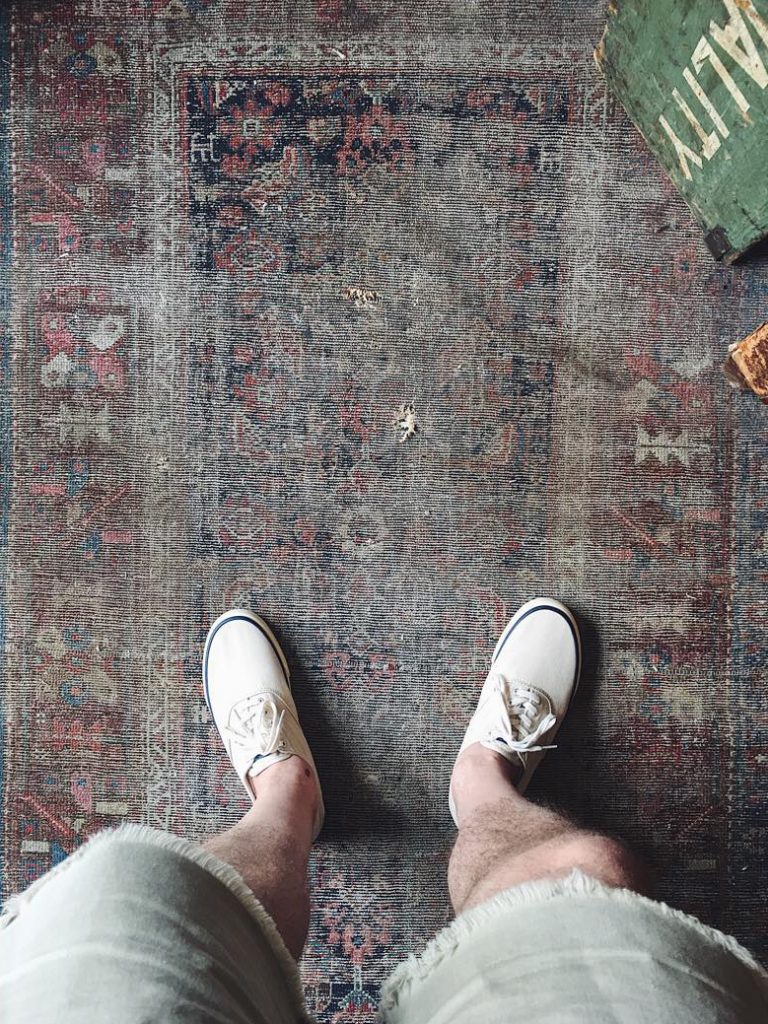
In January of 2014, Karl Lagerfeld held a couture show at the Grand Palais in Paris, where he sent a parade of models down the runway wearing corseted midriffs, gossamer dresses, and pastel-colored sneakers. “Look at the shoes!,” Suzy Menkes wrote of the show in The New York Times. “SNEAKERS at Chanel! [..] No more suffering to be beautiful. Off with the vertiginous stilettos and the chunky club-sandwich soles! In with modern footwear and the female freedom that goes with it.”
The sneakers, sixty-five pairs in total, were made bespoke by the 125-year-old French shoemaking firm Massaro. Each pair required about thirty-hours of handwork to produce, with every silvery slither sequin and shining dot set by hand. They were made from python, with lace, pearls, and tweed, and reportedly ran somewhere in the vicinity of €3,000. In terms of craft, labor, and price, these matched the best of what comes out of John Lobb’s bespoke workshop in London.
Chanel’s show is obviously about womenswear, but it’s a good marker to show where fashion was at the time — which includes men’s attitudes towards rubber soled trainers. Dressing well meant dressing up, and as recently as five years ago, sneakers were verboten. Menswear crawled out of the Dark Ages of the 1990s with men trading their ratty gym shoes for polished brogues, and with time, many men learned to avoid sneakers entirely.
In the last five years, sneakers have come back into menswear, just as they have for women, and their virtues are shared across the aisle. They’re squishy, forgiving, and comfortable. They can be affordable. And they’re often better with casualwear than leather soled shoes of any stripe. Even the Duke of Winsor used to wear canvas deck shoes with his double-breasted blazers (both technically naval clothes anyway). Alexis von Rosenberg, the Baron de Redé, who owned hundreds of bespoke GJ Cleverley shoes, had a pair of tri-striped Adidas sitting alongside his black imitation brogues and four-eyelet oxfords. On the fourth row of his floor-to-ceiling shoe closet, which spanned all four walls of his wardrobe, you can see a pair of black trainers.
I mostly wear boots and derbies during the fall and winter months, but every year around this time, when the weather starts warming up, I begin thinking about camp collar shirts and washed denim jeans, as well as the sneakers that would go with them. The challenge is finding something good. For the last five years, we’ve done roundups of great sneakers for spring — sensible, even if at times adventurous, designs with options for workwear, prep, and contemporary wardrobes. Here are ten more if you’re shopping for a pair this season.
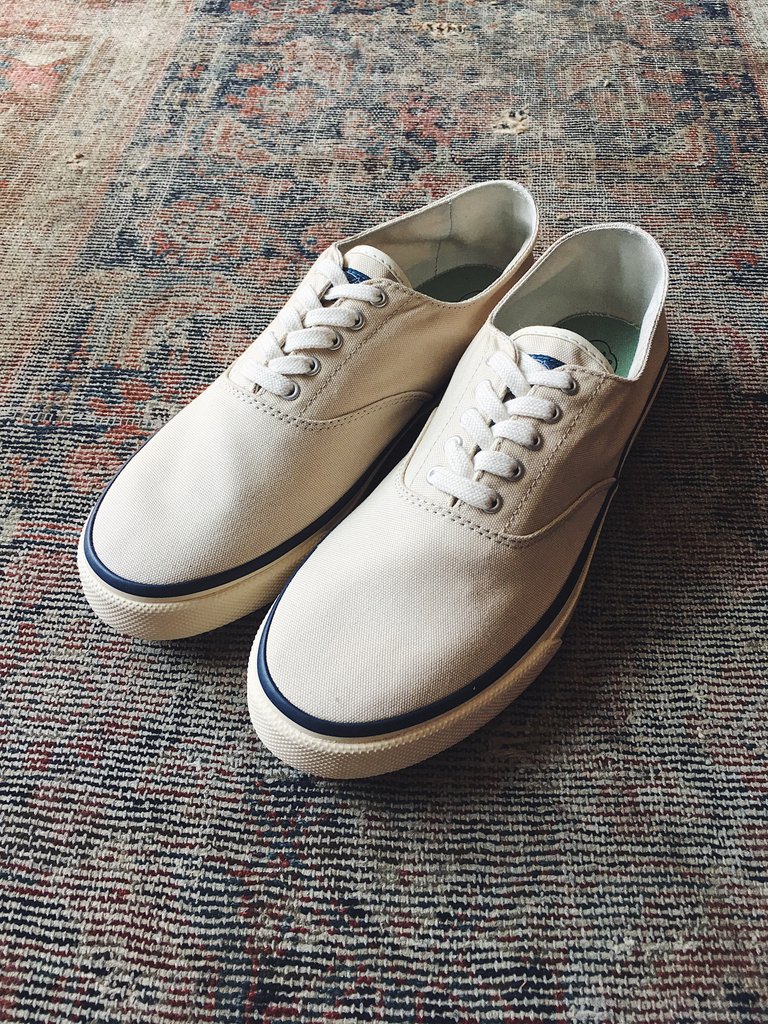
Sperry Cloud CVO ($75)
Most people think of Sperry as a preppy brand for boat shoes and Topsiders, but their Cloud CVO is a much more versatile, three-season option for guys who like Americana and workwear (admittedly prep-adjacent styles). I like how Brian Davis of Wooden Sleepers styles them on his Instagram (he’s also in the main photo at the very top of this post). The shoes, which have been made the same way since the 1930s, go naturally with milsurp, denim, and vintage clothing. During the dawn of skateboarding, kids in Southern California wore CVOs because boards didn’t have grip tape yet and the soles worked well for staying upright. “They’re essentially a vintage shoe that you can buy new today,” says Brian, who sells the CVOs through his shop. “These were issued to sailors during World War II, so they fit in well with vintage militaria and khaki chinos. They also work with the 1960s Ivy Style look, like you’d imagine on Mr. Rogers. When I think of the quintessential canvas sneaker, this is the image I have in my head.” Wooden Sleepers has both the birch white and navy blue colorways available at their Brooklyn-based shop and online store for just $75.
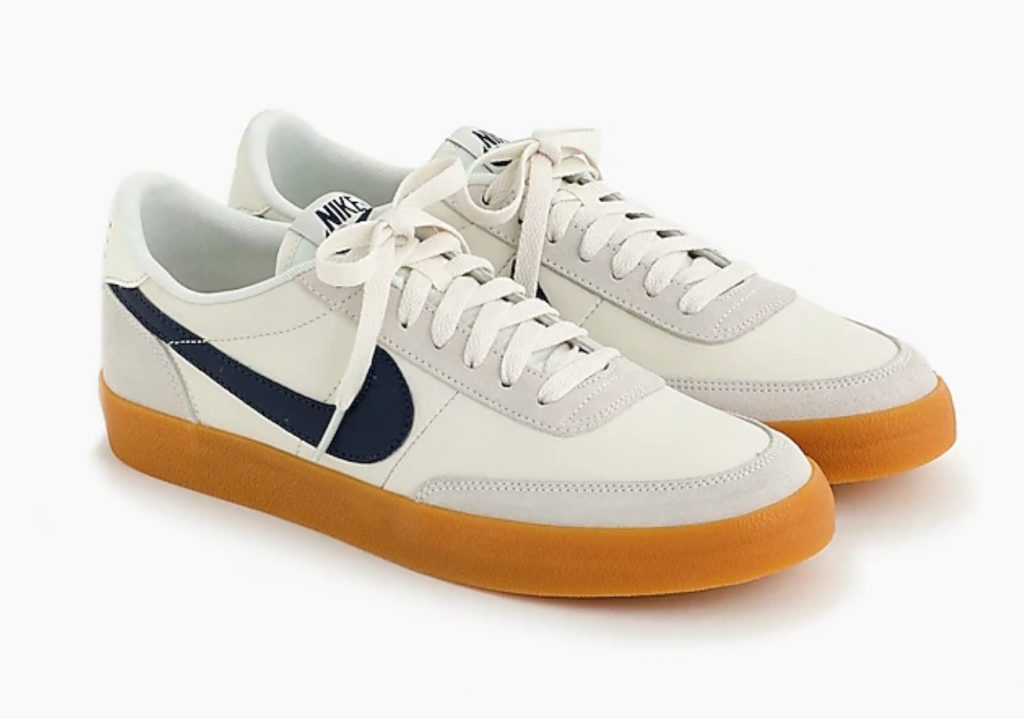
Nike Killshot 2 ($90)
Nike’s Killshot 2 are affectionately known as the Memeshots on Reddit’s Male Fashion Advice, a subreddit community of 2 million people that spans the range of avant-garde dressers to beginners who are just starting to build a better wardrobe. The shoes are popular for good reasons. They’re reasonably affordable at $90 a pair, they reference classic 1970s designs, and they go with many of the styles often recommended at Male Fashion Advice (e.g., bizcaz basics, workwear, and prep).
The Killshots are minimal without being boring; sporty without being overdesigned. The gray suede mud-guard and white uppers go with almost any color bottom; the gum soles and navy swoosh (now also available in burgundy) lend some nice detailing. The shoes are a close cousin of Adidas’ Sambas, which Racked dubbed “The Official Shoe of Cute Boys.” Which makes them perfect for a guy like me because I too am just a close cousin of someone good looking. Get Killshots if you want something that’s handsome but not visually obtrusive, relevant without being trendy. They work especially well for casual offices.
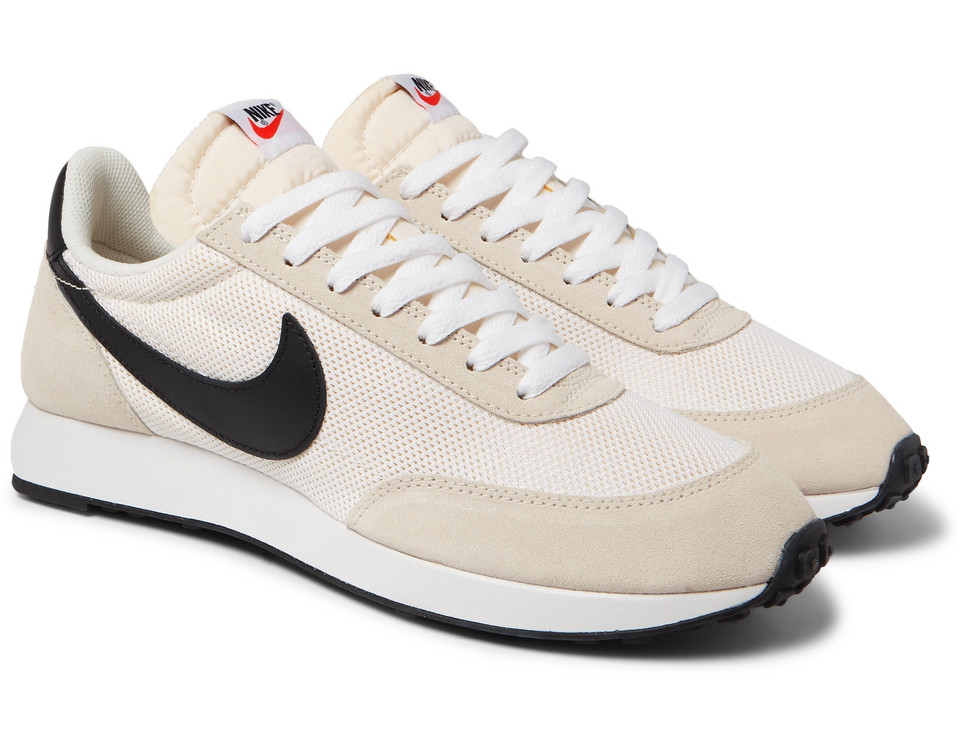
Nike Air Tailwind 79 ($90)
In the 1970s, shortly after Japan fell in love with Ivy Style, the Japanese started noticing that American college students were no longer wearing neckties with tweed jackets to classes. Instead, many were repurposing outdoor brands such as Sierra Designs and Eddie Bauer into their everyday attire. The look was later coined “Rugged Ivy” (or sometimes “Heavy Duty Ivy”). In his book Ametora, David Marx described it as two sides of the same coin. Students at elite colleges still wore blazers, but ones in more rural locales such as Dartmouth were more likely to be found in down jackets and denim.
For that kind of style, you could go with Danner hiking boots or LL Bean boots, but my favorites are retro-running sneakers. Meaning, the sort of track styles you might find in the ‘70s and ‘80s (a look so beloved by the Japanese, the editors of Popeye dedicated a spread to it in their inaugural issue). They lack the heft of true-blue rugged boots, but they’re also better suited to sunnier weather.
Nike’s Air Tailwind 79s are perfect for that sort of wardrobe. When they were first released in 1979, they were Nike’s first shoe to feature the company’s Air Sole, which was invented by a trainer-obsessed aerospace technologist named Frank Rudy. The modern version has been updated a little with a sleek textile upper, foam tongue, and revered Waffle outsole. Wear them with 60/ 40 mountain parkas, Levi’s jeans, and Champion sweatshirts. They can also serve as a nice sportswear foil to jeans and a trim topcoat combination.
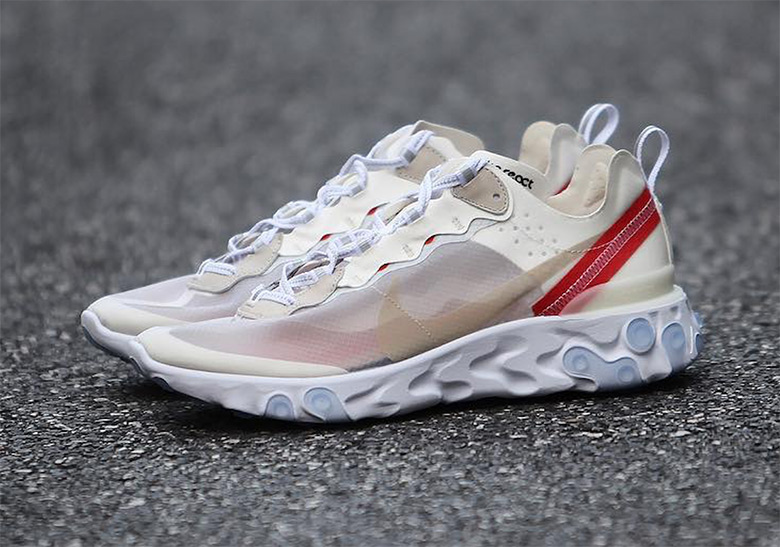
Nike React Element 87 ($185+)
When they first appeared on Jun Takahashi’s Undercover runway show last year, Nike’s React Element 87s became an instant online hit. They fuse two themes in sneaker design happening at the moment: a chunkier silhouette with that molecule-decorated sole and a deconstructed upper with a semi-translucent shell, low-slung Swoosh, and trail-style lacing system. Since the uppers are semi-translucent, your socks will slightly change the colorways of these styles, although most people find they just alternate between gray, black, and white.
On first blush, these sneakers look like they won’t go with anything, but in being so odd-ball and futuristic, they also go with nearly everything. Greg Lellouche of No Man Walks Alone pairs them with contemporary casualwear; Andrew Chen of 3sixteen teams them with workwear. “I wear them with blue jeans, drawstring utility pants, and olive fatigues,” Andrew says. “The sail colorway is actually pretty mellow and versatile.”
If you shop for a pair, beware of counterfeits and fishing sites that are just trying to steal your credit card info (if the site doesn’t have any contact information beyond an empty “submit form” page, that’s a red flag). Your best bet is to bid for a pair through StockX, where there’s an in-house authentication process. I like the sail and green mist colorways best, but they’re the most expensive at about $500 per pair. Desert sand is a good, semi-affordable alternative for around $200. “I have a pair of the desert sands and find they go well with olive drab or khaki bottoms,” says Greg. “They also look better with beige or grey socks, rather than white.”
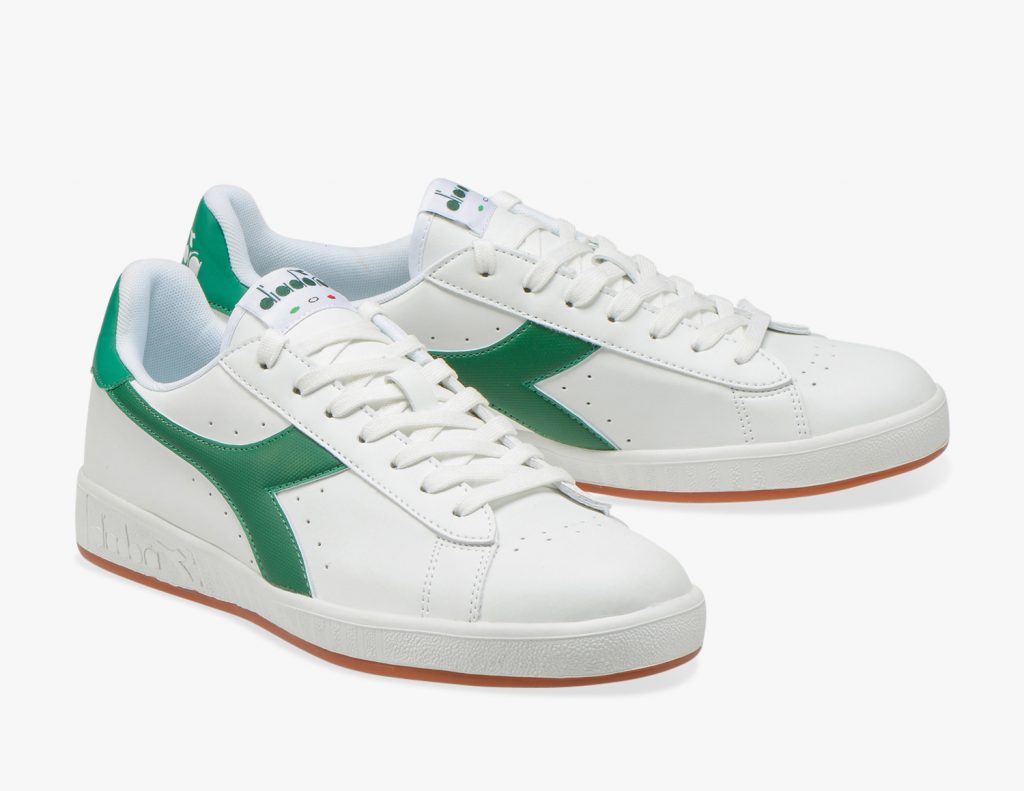
Diadora Game Low ($90)
Diadora is an Italian company that started out making mountain boots in the 1940s before they switched to athletic gear and sneakers in the 1960s. I like their throwback designs, which are often rooted in 1960s and ’70s running, soccer, and tennis culture (often considered to be the Golden Era of many classic sportswear styles). Sid Mashburn, one of our favorite retailers, sells them alongside their Chelsea boots and tassel loafers. The sneakers go well with the sort of Americana and prep clothing you can find at Sid Mashburn’s stores — slim-straight jeans, oxford cloth button-downs, rain macs, field jackets, and chunky sweaters. Amazon has some on sale right now for as little as $30, but be aware that some have distressed and waxed soles, which I think look less compelling.
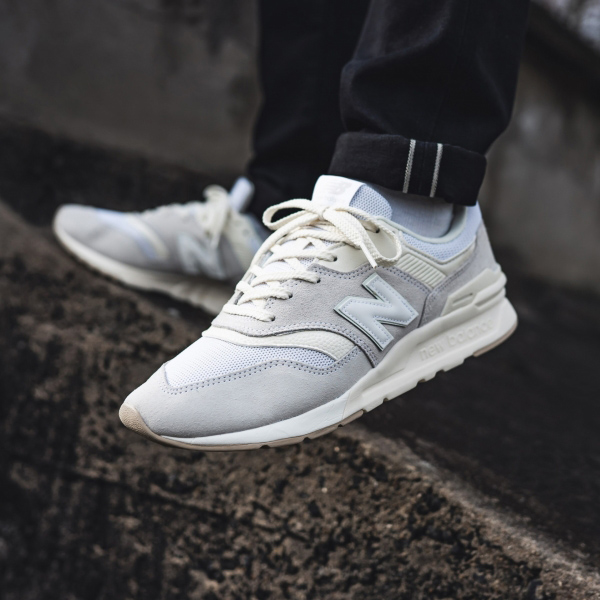
New Balance CM997HCB ($100)
The 997H has all the things we love about New Balance: a classic runner style with off-white and gray suede paneling, as well as a lightweight outsole that combines comfort and stability. It’s a little more modern looking than some of New Balance’s chunkier silhouettes and isn’t as dad-styled as the company’s techy-heavy options. As Pete recently wrote in his New Balances guide, these runners have impressive relevance across the men’s style spectrum. “Maybe in part because there are so few connotations with New Balance — unlike, say, basketball or tennis sneakers — they can be worn in nearly any current sneaker-friendly context. Fashion dudes wear them to runway shows. Minimalist wardrobe palette guys wear them. Workwear guys wear them. Ivy guys wear them. Americana guys wear them. I guess maybe people still wear them to run?”
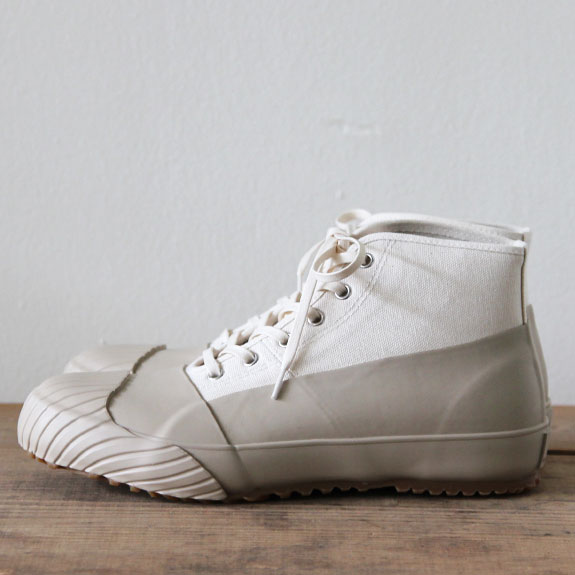
Moonstar All-Weather Shoes ($285)
Japan’s Moonstar factory makes some of menswear’s favorite niche sneakers, including those from Huf Classics and Shoes like Pottery. Like modern Vans Authentics or Chuck Taylors, the shoes are made using a vulcanization method: shoe soles are bonded (glued, essentially) to uppers with a wrapped piece of rubber tape, then baked in a kiln, enabling a chemical reaction that seals the sole, tape, and upper. The difference between these and cheaper vulcanized-rubber-sole sneakers isn’t massive, but Moonstars stand out a little more in that they’re made in relatively small quantities, in a country with reasonable labor practices, and you don’t see them every day. They’re also, on the whole, more solidly built.
I particularly like their All-Weather sneaker high-tops, where the rubber sole wraps around the top of the shoe, forming a mudguard that protects the wearer from early spring showers and low Instagram like counts. The shoes are kinda goofy looking, but in the best of ways, and they go well with similarly off-beat workwear — rolled olive-green fatigues, chunky sweaters layered under field jackets, shallow five-panel caps, and naturally, slim-tapered jeans.
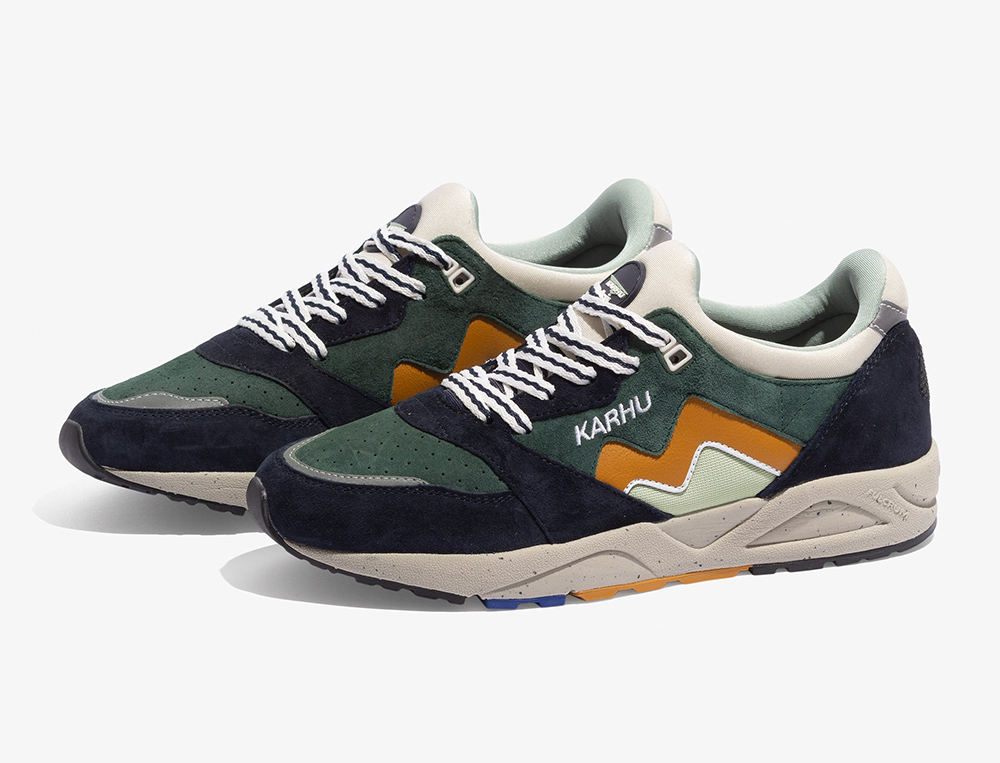
Karhu Aria ($130)
Karhu is a somewhat obscure Finnish brand focused on sports performance products, but they also have a small line of lifestyle shoes. Their sneakers feature something they call their “fulcrum technology,” which was developed in the 1980s in collaboration with the University of Jyväskylä. Their soles have a V-shaped spring that supposedly allows you to run faster, farther, and easier because of how it softens your step and gives you a better mid-foot landing. For lifestyle shoes such as the Aria, however, the technology is mostly a marketing bullet point. I mainly like them for their slightly chunkier silhouette and retro-inspired styling, which does a good job of riding the line between tech-heavy ’90s running shoes and ’70s era nostalgia. They also come in some handsome and slightly unusual colorways, which gives you options beyond the usual creams and grays. Wear them with outdoor and workwear-inspired brands such as Engineered Garments, Orslow, and Patagonia. They’re available at Barney’s, East Dane, Huckberry, Peggs & Son, and Bows and Arrows.
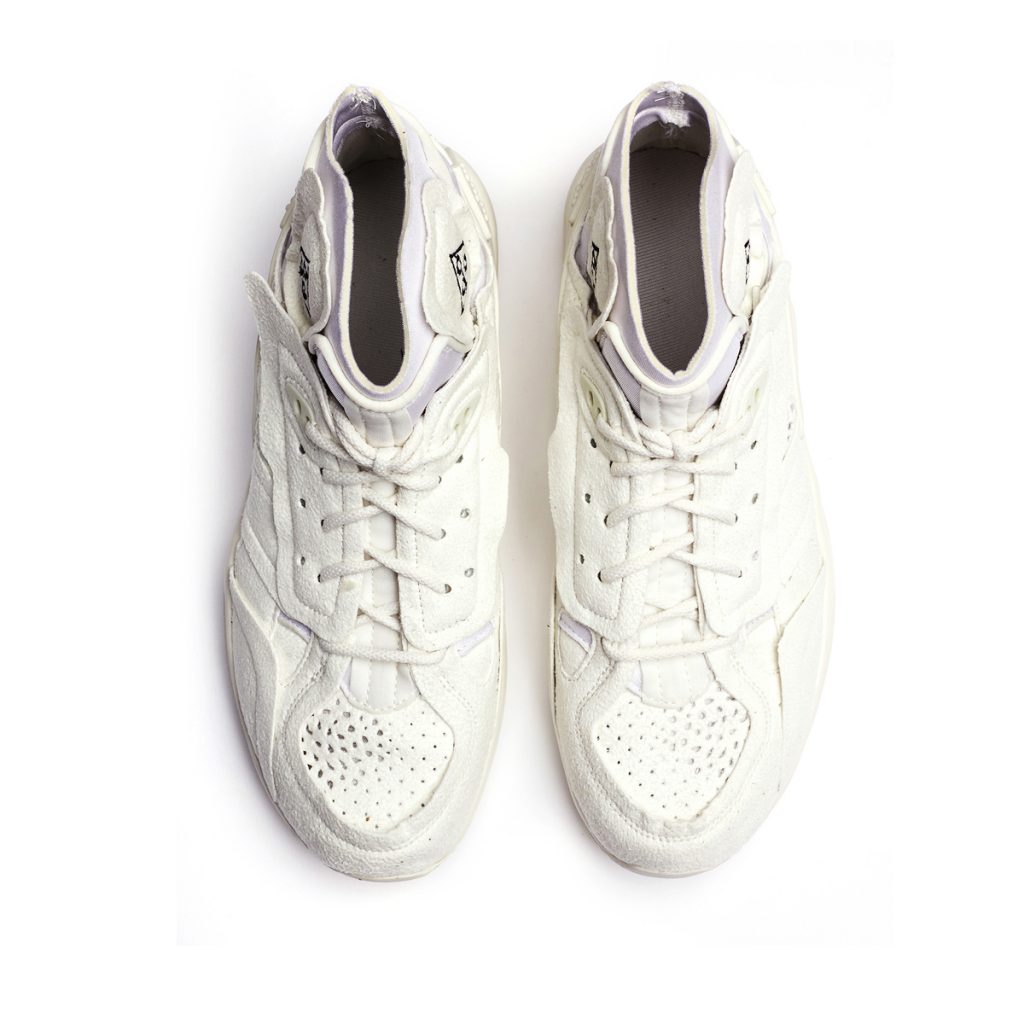
Comme des Garcon x ACG Mowabb ($290)
If you want something more unusual than just retro-inspired sneakers, Comme des Garcon’s take on Nike’s ACG Mowabbs is a great look. They’re a more directional design with slightly mismatched panels, felted fabric uppers (which look like suede but aren’t), and a Neoprene sock liner. Nike’s trail-ready Air Mowabb has been a favorite of sneakerheads, techwear guys, and actual hikers for years, but CDG’s version brings it into a more fashion-forward look that works well with both contemporary and workwear wardrobes. The mid-top design looks great with cropped trousers and fatigues; the chunky midsole and plastic heel counter lend some interesting detailing. The sneakers sold out quickly last year when they first appeared at Dover Street Market, End, and SSENSE, but they were recently re-released at Barney’s.
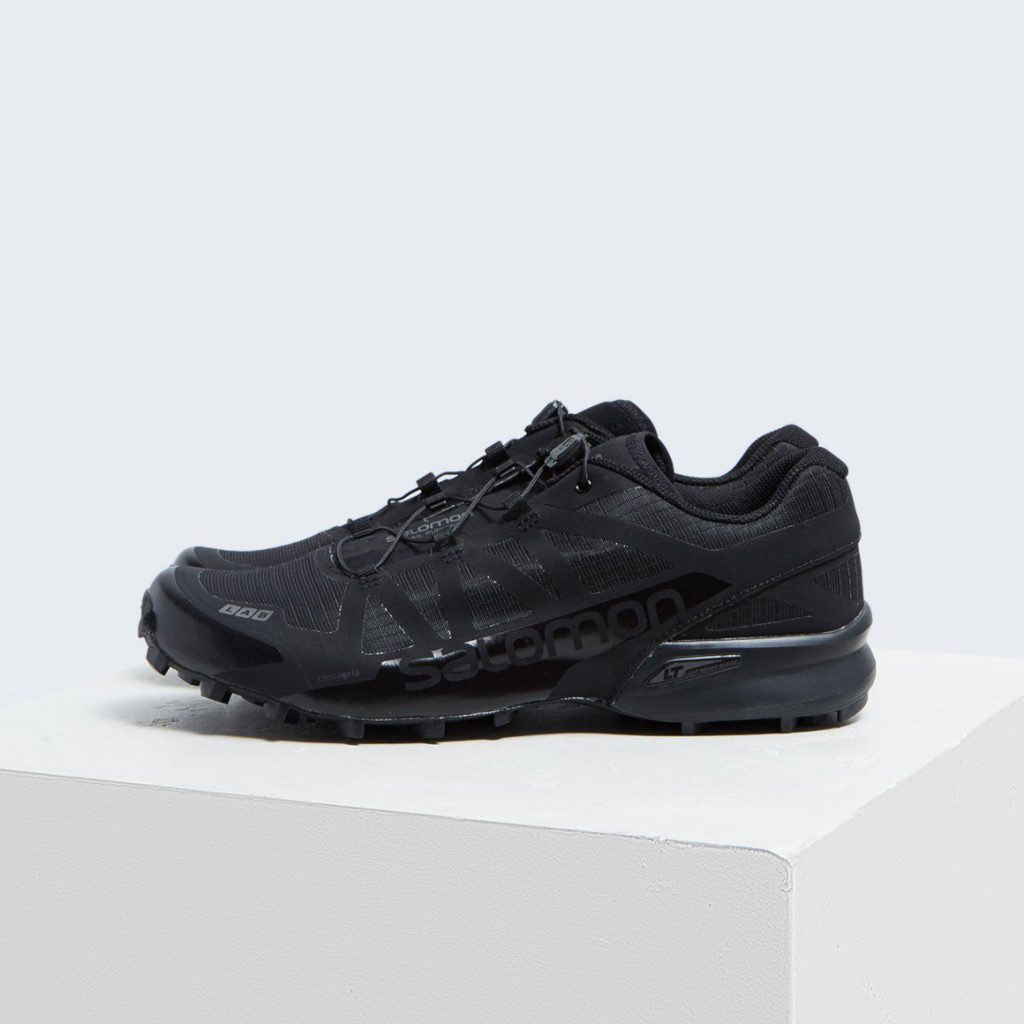
Salomon’s Speedcross and Others ($220+)
What began a few seasons ago as pushback against the all-white, minimalist sneaker obsession of the early 2010s has mutated into what Vanessa Friedman at The New York Times recently described as “peak sneaker silliness.” “The pressure is on to up the ante with each new design — to make it crazier! and bigger! and artier! (and, sometimes, uglier) — the form has begun to flirt with being a parody of itself,” she wrote. Salomon’s trail runners are admittedly smack dab in the middle of that hype. They’ve been featured in Palace lookbooks and CMMN SWDN runway shows; they’ve collaborated on special edition sneakers with Boris Bidjan Saberi and The Soloist; and they’ve been imitated by Balenciaga.
At the same time, they also have genuine performance pedigree. Salomon is a French manufacturer of skis, snowboards, and technical running shoes that just so happens to fit neatly into the tech-heavy and overengineered looks that are popular right now. I like them in reasonably subdued and semi-classic looks involving similar outdoor brands such as Patagonia or outdoor-inspired labels such as Nonnative. They also work with more expressive forms of contemporary minimalism, such as the things you’d find at Totokaelo. Their Speedcross offers great support and comfort, as well as a unique and easy-lacing system, while their appearance looks techy without having the bulkiness of some (admittedly ridiculous) designer options. Check out models such as the Speedcross, XA-Comp ADV, and S/LAB series at Mr. Porter, Totokaelo, and SSENSE.







